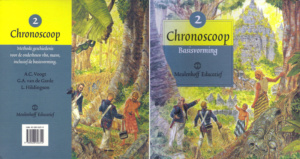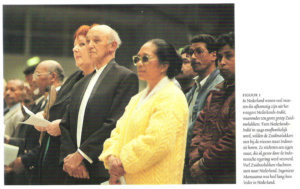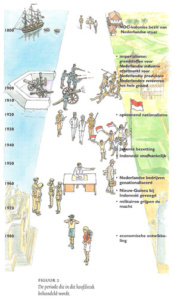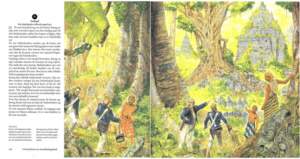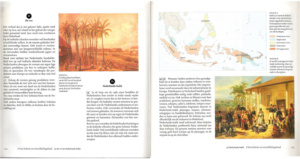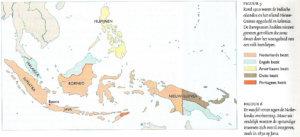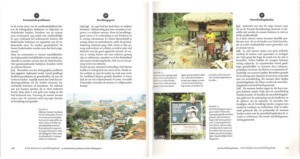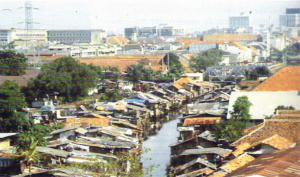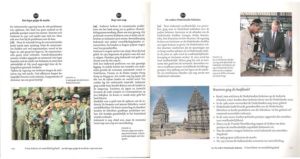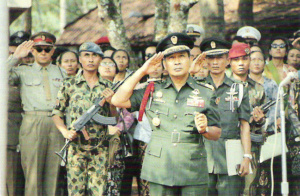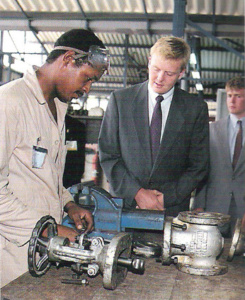[Chapter from Dutch history schoolbook, used in 1998]
Chapter 8: From colony to developing country
What are we going to do in this chapter? Right after Second World War, there were only about fifty independent states around the world. Nowadays there are more than one hundred and fifty. Especially in Africa and Asia dozens of new states have been established. For a long time these regions had been colonized by European countries such as England, France, Portugal, Spain and the Netherlands. In this chapter we will see how the most important colony of the Netherlands, the Dutch East Indies, became independent under the new name Indonesia. We will also look at the problems that Indonesia and other former colonies had to deal with.
Caption: Many people from the former Dutch East Indies came to the Netherlands, including a large group from South Maluku. When the Dutch East Indies got independent in 1949, the South Moluccans did not want to be part of the new Indonesian state. They established their own state, which was quickly conquered by the Indonesian government. Many Moluccans then fled to the Netherlands. For a long time, Manusama was their leader in the Netherlands.
Story
Four Dutch people want to see the temple. The sun is high in the sky. Bung and his two friends are walking the dusty path. The four Dutch people behind them are panting. They look ridiculous with their red, sweaty heads. The four Dutch people are working on the construction of a large fort between the two main cities of Central Java. That new fort must prevent Javanese princes from starting an uprising against the Dutch. Today they want to visit the temple. Bung and his friends have to show the men the way. He does not like that. The Dutch are rude and disrespectful. They remove sculptures from the temples to bring those with them. They do not care if the temple spirits get angry. Bung can understand basic Dutch. His parents used to work in the house of a Dutch merchant. But he prefers to pretend as if he does not understand the four men. One of them is grumbling. “That temple can never be something special. Javanese are after all too lazy to build decent houses for themselves.” The temple looms up between the trees in front of them. Boeng turns around and points the Dutch to the huge, half-collapsed towers. The four men look stunned. They stop talking and stand still. They did not expect this to happen.
Caption 1) Shortly after 1800, the Dutch began to study the ancient temples on the island of Java. Java was then a Dutch colony. The Dutch perceived the Javanese as lazy and stupid. But when they saw these beautiful Javanese structures, they were impressed after all.
The VOC
The story you just read is situated around 1800 on Java, an island in the area that was formerly called Indië. Java was then dominated by the Netherlands. Hundreds of different peoples lived on the Indian islands. Simple farmers inhabited most of the areas. There were also principalities with a highly developed culture. Nomadic hunters and collectors were roaming the jungle. Around 1600, the Dutch trading company VOC established colonies on many of these Indian islands. The Dutch forced the princes to sell products for low prices: coffee, tea and spices. The VOC shipped these products to Europe and sold it there making a lot of profit. As long as the princes supplied enough products, the VOC did not interfere with the government. But if a monarch did something that the Dutch did not like, they destroyed the fields in his area or bluntly murdered him. After 1795 the VOC colonies became property of the Dutch state. Other Europeans also had colonies in America, Asia and Africa and exiled the population there.
Dutch East Indies
In the course of the 19th century, the Dutch expanded their power in the Indies even further. They made sure they were in charge. The local princes had to do exactly what the Dutch officials and military personnel ordered them to do. The Dutch also conquered many new areas. The inhabitants fiercely resisted, but they could not compete with the Dutch rifles and cannons. Thousands of them were killed. Shortly after 1910, the Dutch possessions in the Indonesian islands formed one large colony: the Dutch East Indies. Many different people lived together in one state; not out of their own free will, but because the Dutch had subjected them all.
When countries try to expand their territory by dominating other people, we call that imperialism. Imperialism was caused by industrialization in Europe. Manufacturers in the Netherlands needed cheap raw materials such as rubber, palm oil, petroleum and tin. They also looked for customers for their products: woven cotton fabrics, machines, trains, ships, radios, telephones, lamps and so on. Many Dutch people therefore started plantations, mines, oil companies and trading companies in the Dutch East Indies. Factories were hardly built. The colony was heavily dependent on industry in the Netherlands. The Dutch East Indies became prosperous. But apart from the Dutch, almost nobody profited from this prosperity. The ordinary people had to work hard for little money on the plantations, in the mines and oil fields.
Caption 2) The main trading post of the VOC was the port city Jakarta. In 1619 the Dutch gave the city a new name: Batavia. That means ‘the Netherlands’.
Caption 3) There was fierce resistance against the Dutch domination. But in the end the rebellious inhabitants had to surrender everywhere, as on Java in 1830.
Caption 4) Around 1910 the Indian islands and the island of New Guinea were divided into colonies. The Europeans had drawn new boundaries that sometimes sliced right through residential areas.
Growing nationalism
For the new companies and their administration, skilled workers were needed. That is why the Dutch founded schools around 1900 where residents of the Dutch East Indies were trained as civil servants, technicians and doctors. Some went to the Netherlands to study at a university. They got to know European views on politics, such as nationalism. They also felt that the peoples of the Dutch East Indies were entitled to have their own state: Indonesia. When they returned home, they established political parties. This increased the resistance against the Netherlands. In 1918 the Dutch government slightly met their demands. A parliament was established in which, in addition to Dutch citizens, representatives of the population were also present. But this parliament was only allowed to give advice. Furthermore, the government banned all nationalist parties. Sukarno, the leader of the main party, was imprisoned in a concentration camp with other nationalists. In 1936 the parliament asked the Dutch government to work towards independence. The Dutch rejected this request. They thought that nationalism had little support.
The Japanese occupation
In early 1942, during the Second World War, Japan conquered Southeast Asia, including the Dutch East Indies. For the Dutch in this region a terrible period followed. Most were arrested and imprisoned in camps. A lot of men had to perform forced labour. More than twenty thousand Dutch people died due to illness, hunger and abuse.
The local population suffered less from the Japanese occupation. Moreover, the nationalists got new hope. The Japanese had shown that the Netherlands was not invincible. They even promised that in the future an independent state Indonesia could be established within the Japanese empire. Some nationalist leaders therefore worked together with the Japanese. The Dutch saw the collaboration between the nationalists and the Japanese occupiers as betrayal. They could not understand that they themselves were also foreign occupiers.
Struggle and independence
In August 1945 Japan surrendered and the Second World War ended. While the Dutch population was still imprisoned, Sukarno established the independent republic of Indonesia. The capital Batavia got its old, Indonesian name: Jakarta. Sukarno became president of the new state. This came as a shock to the Dutch. They wanted to restore their authority and thought that the local population wanted that too. They figured that without the Dutch East Indies, the Netherlands would become a poor and insignificant country. But Indonesia received support from the United States. The latter felt that the era in which European countries ruled large parts of the world was over. The Netherlands had to accept the situation. After difficult negotiations and two short wars, they came to an agreement at the end of 1949. The Netherlands recognized the independence of Indonesia. This transition from colony to its independent state is called decolonization. The Dutch kept the west of the island of New Guinea. They believed that this area did not belong to Indonesia because the people were totally unrelated to Indonesian people. Eventually the Dutch had to leave there as well. In 1963 New Guinea was added to Indonesia. Shortly after the decolonization, the inhabitants of the South Moluccan islands proclaimed their own republic. They did not want to belong to Indonesia. Sukarno destroyed this state using a lot of violence. Then thousands of South Moluccans fled to the Netherlands. In New Guinea and some other areas, revolts broke out against the Indonesian government.
Captions 5) During the Second World War, the Indonesian nationalists received support from the Japanese. For example, they were allowed to issue a magazine. On the front cover you see people waving the flag of Japan together with the future flag of Indonesia.
Caption 6) The social classes in the Dutch East Indies. The Dutch were most respected. The middle class was formed by Chinese merchants and people who were involved with the Dutch; civil servants, soldiers and intellectuals such as doctors, lawyers and teachers.



Economic problems
In the first years of independence, the most important companies in Indonesia remained in Dutch hands. As a result, the new state was still not economically independent. In 1957, the Indonesian government declared all Dutch companies Indonesian state property. They were nationalized. The last Dutch were forced to leave the country. Now new difficulties occurred. The Indonesian managers were less educated and less experienced than the Dutch. Many nationalized companies deteriorated and lost customers. Moreover, the most important problem was not solved. Indonesia mainly exported cheap agricultural products and raw materials to the western countries. At the same time, the country had to import expensive industrial products from those countries, for example machinery or artificial fertilizer. Prosperity could only grow with more local industry. But that requires a lot of money and Indonesia did not have that. The vast majority of the people were poor. The poverty was even worse because the population rapidly grew.
Population growth
In 1940 the country had nearly 70 million inhabitants. Twenty-five years later, about 110 million people lived in Indonesia. Due to the population growth, there were too many children compared to adults. For example, there were only a few doctors and hospitals that is why the health care deteriorated. There were also not enough teachers and schools, while there was a great need for well-educated people. There was a shortage of farmers to grow enough rice for everyone, so rice had to be bought abroad. There was also not enough work for everyone. Especially on Java there was overpopulation. Many farmers had too little land to live on. More and more often they went to the cities in search for work. As a result, the capital city Jakarta grew into a metropolis in a very short time. In poor, polluted slums, people lived in homemade houses.
Developing countries
Indonesia was not the only new state that arose after the Second World War. Around the same time, most colonies in Asia and Africa became independent. The same problems occurred in all these new states. In South American countries, which had previously got independent, the situation was comparable. There was no political unity in many of these new states. A lot of revolts and wars broke out. Often the army seized power to restore order. Furthermore, the former colonies had little industry. They mainly exported cheap raw materials and had to import expensive industrial products. In this way they remained economically dependent on Western countries. Moreover, the population grew rapidly. As a result, their economy did not develop. We call these countries ‘developing countries.’ Together the developing countries are called the ‘Third World.’ Western countries recognized that their former colonies could not develop without help. They lent the developing countries money for the improvement of agriculture and the construction of the industry. They sent experts, who taught the population how to handle modern machines and techniques. That happened in Indonesia too. For example, the western countries tried to improve the situation together with the developing countries. This is called development cooperation.
Caption 7) Millions of residents of Jakarta live in slums. Most of them have moved from the countryside to the city in search for work. They have built houses of waste or cheap material while there is no water and no electricity. Ditches or wastelands are used as toilet. There are no schools and hospitals.
Caption 8) In order to prevent population growth, the Indonesian government propagated small families. However, in Indonesia old people do not receive pension. They are dependent on their children. That is why many Indonesians take it for granted: rather a few children now than growing hungry later. This keeps the population growing.
The army seizes power
The Indonesian government could not solve the problems. The country was not a unity and the political parties were in disagreement. That is why Sukarno seized more power in 1957. But even then he could not control the problems. Because of the poverty, the Communist Party got more and more supporters. But the communists also had many opponents, especially in the army. In 1965, the army intervened. The communist party was forbidden. Hundreds of thousands of people were arrested and killed. The army also limited the power of Sukarno and eventually deposed him. He was succeeded by the most important general, Suharto. During the Suharto government, the military got a lot of power. Many officers were given important positions such as minister, mayor or director of a large company.
Step-by-step
Soeharto decided to handle the economic problems of the country firmly. Development cooperation alone was not enough. He tried to persuade Western companies to set up factories in Indonesia. In addition, Indonesia cooperated with other developing countries. That way they could ask higher prices for their raw materials. Soeharto’s approach did not always work. But he was lucky. In 1973 prices for oil began to rise rapidly. As a result, Indonesia made a lot of money from oil export. Indonesia could also benefit from its favourable location. In some countries north of Indonesia the economy grew rapidly: especially in South Korea, Taiwan and the small states of Hong Kong and Singapore. A little further away was Japan, which became one of the richest countries in the world. In the South there was the affluent state of Australia. Indonesia started to trade more and more with the countries in the area. Tourists from Japan and Australia came to view the ancient temples and royal palaces on Java. That is how more and more money came into the country. Finally there was money for the construction of the industry. There were many new factories, especially textile factories. Wages were low and the factories could make cheap products. They could easily be sold abroad. Indonesia is still poor, but the economy is developing step by step.
The other Dutch colonies
When Indonesia became independent, people in the Netherlands started to think about the other colonies such as Suriname and the islands of the Netherlands Antilles: Curacao, Aruba, Bonaire, Saba, St. Eustatius and St. Maarten. The government decided to grant Suriname and the Netherlands Antilles its own administration. The Netherlands wanted to prevent an escalation comparable to the Dutch East Indies. In the years after 1960 the independence movement in Suriname became stronger. In 1975 the country became independent. Unfortunately, the Surinamese economy did not run well. Moreover, there were conflicts between different groups. The army was in power for some time. The six Antillean islands are still connected to the Netherlands. [Ed.: until 2010.]
What was this chapter about?
* Around 1600 the Dutch founded colonies in the Indian islands. Later these colonies became possession of the Dutch state.
* In the 19th century the Dutch conquered even more territory.
* The Dutch East Indies supplied raw materials to the Dutch factories and bought products from those factories. Hardly any industry emerged in the area itself.
* In the 20th century, political parties were founded that strived for independence.
* Directly after the Second World War, the leaders of these parties proclaimed the independent republic of Indonesia.
* Like other former colonies, Indonesia became a developing country.
* In 1965, soldiers seized power.
* After 1973, the Indonesian economy was developing.
Caption 9) Tourists improve the economy. They visit the ancient temples, such as those in Java.
Caption 10) The six Antillean islands are still depending on the Netherlands. Many companies are still in Dutch hands. Except this workshop that Prince Willem-Alexander visited.
————————————————————————————————————————-
Letter Jeffry Pondaag, October 1998
[In 1998 K.U.K.B. chairman Jeffry Pondaag sent a letter to the rector of his daughter’s school in protest of the history book ‘Chronoscoop’, read the letter + reply below or check the video of the Histori Bersama event from last October 19th. At min. 2:14 Pondaag tells about the confrontation with his daughter’s history teacher.]
Dear Mr. Vermeulen, 23 October 1998
I was deeply offended and angry when my daughter Wendy asked me if Indonesia got independent in 1949. She showed me this from the history book I mentioned before. After further reading this chapter, I found a lot of mistakes. More worrisome was that it didn’t mention anything about the so-called ‘police actions’ from 1947/1949.
I want to remind you that your Queen attended the fifty years anniversary of Merdeka on August 17, 1995 at the invitation of our President. As far as the term Dutch ‘colony’ is concerned, I think that it is more appropriate to talk about an ‘occupation’ that lasted for three hundred and fifty years.
With this letter I explicitly protest that my daughter Wendy has to learn this chapter.
Hope to have informed you sufficiently, I await your answer. I further want to use this opportunity to inform about the reply of my letter dated July 18th, 1998. I will send a copy.
With kind regards, Yours sincerely,
Pondaag J.M.
Download original letter (in Dutch): ![]()
————————————————————————————————————————-
Dear Mr. Pondaag, Heemskerk, December 2, 1998
In response to your letter regarding the history method “Chronoscoop” I want to inform you about the following. We have been working with this history book for quite some time and to full satisfaction of teachers and students. We simply assume that the authors of Chronoscoop have correctly presented the facts in the chapter concerning Indonesia. Of course, you are free to have your own views on the role of the Netherlands during this period, just as Indonesians are free to protest against their current rulers and predecessors. If you are of the opinion that the method contains inaccuracies in the chapter about Indonesia, I advise you to contact the publisher of the Chronoscoop. You will find the name and address on one of the first pages in the book.
With kind regards,
G.W. Vermeulen, – Rector
Download original reply (in Dutch) ![]()
————————————————————————————————————————-
Download chapter 8 (in Dutch, scan 3MB): ![]()

